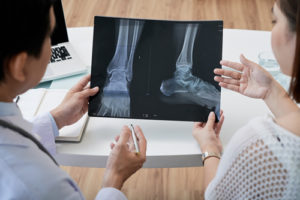Advanced Diagnostics
 At Tower Podiatry we provide advanced diagnostics in the form of X-ray facilities, diagnostic ultrasounds, and vascular circulation testing.
At Tower Podiatry we provide advanced diagnostics in the form of X-ray facilities, diagnostic ultrasounds, and vascular circulation testing.
X-ray Facilities
In all three Tower Podiatry locations, we have state of the art in-office complete X-ray machines which provide radiology results within minutes. These x-ray facilities are easily accessible for adults, pediatrics, and patients with disabilities. X-ray images are reviewed and discussed with patients to identify a foot ailment along with the proper course of treatment.
Ultrasound Studies
Musculoskeletal ultrasonography is a very powerful diagnostic tool for the diagnosis of a wide array of foot and ankle problems. Ultrasound is an imaging technique used to visualize soft tissues such as muscles, tendons, and organs, as well as blood flow, with real time images. Ultrasounds are based on sound waves which are emitted from a transducer probe that is applied to the foot. These sound waves will pass into the body and then reflect to the object that the sound waves encounter. An object with a high density appears white or brighter on the record image, while objects of low density will appear black or dark on the image. Some foot disorders that ultrasounds are used for include but are not limited to:
- Foreign bodies
- Neuroma
- Soft tissue masses
- Bursitis
- Ligament Injuries
- Tendinitis
- Plantar Fasciitis
- Tarsal Tunnel Syndrome
Vascular Circulation Testing
Vascular circulation testing is most used for patients who have Peripheral arterial disease (PAD). PAD is a condition in which fatty deposits build along the walls of the arteries that carry blood to the arms and legs. Signs of PAD include cramping pains in the legs, burning or aching in the feet, color changes in the skin, sores, and no pulse in the feet. However, research shows that 20-50% of patients with PAD have no symptoms.
Who is at most risk for PAD?
Smoking is the number one risk factor for PAD followed by diabetes. Those who are diabetic should keep a strict control of their blood sugar to avoid problems which result from PAD. Older age and people with a family history of heart disease are at a greater risk for PAD.
How do you test for PAD?
A non-invasive vascular examination is the first step for PAD. This test is simple and done by placing blood pressure cuffs about the leg at the different levels to measure the blood pressure and obtain an image of the pulse wave form. These images will guide your doctor in seeing evidence of PAD. You may be advised for treatment or further testing and treatment with a vascular doctor.
